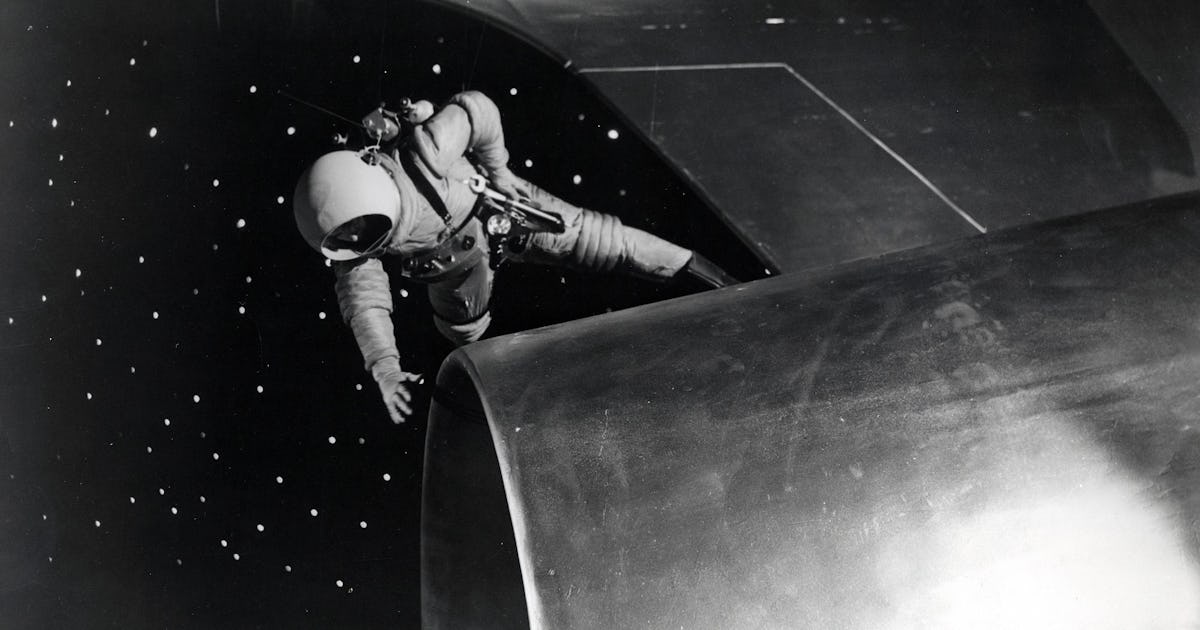Fascination with science-fiction worlds is baked deeply into the origins of film history. Beginning with Georges Méliès’ groundbreaking wizardry in 1902’s A Trip to the Moon, the genre’s possibilities expanded wildly over subsequent decades. In 1925’s The Lost World, Willis H. O’Brien used split-screens and innovations in stop-motion animation to put actors onscreen with dinosaurs, while Fritz Lang’s 1927 masterpiece Metropolis gave us class struggle, robots, and gorgeous scale. Early science fiction fueled pioneering horror, including Frankenstein (1931) and The Invisible Man (1933). But the genre truly kicked into high gear in the aftermath of the world wars. Social factors like the atom bomb paved the way for the 1950s’ golden age of science fiction cinema. That genre-defining science fiction wave was sparked 75 years ago by the most influential animator you likely never heard of, George Pal, and his classic of realist space-race cinema, Destination Moon.
George Pal made a name for himself in Hollywood through his pioneering use of “replacement animation” stop-motion in what he called “Puppetoons,” beginning in 1930s Europe before leaving for the U.S to make them for Paramount in the 1940s (for which he won an honorary Oscar in 1943). Instead of using a single, movable puppet (think Willis H. O’Brien’s King Kong or Ray Harryhausen), characters “move” in replacement animation via the substitution of intricate replacement parts (in Pal’s case, a massive array of hand-card wooden pieces). The traditionally painstaking technique went on to be adopted by gifted animators like Henry Selick (A Nightmare Before Christmas, Coraline), the team at Laika Studios (Kubo and the Two Strings), and used to animate Pinocchio himself in the Oscar-winning Guillermo del Toro’s Pinocchio.
Pal produced 42 Puppetoons in the United States, which netted the animator seven Academy Award nominations for Best Short Subject – Cartoon. By the time the series was ending (in part due to rising production costs), Pal sought to produce live action features. He netted a production deal with Eagle-Lion Films for a pair of films. The first was The Great Rupert, an often-forgotten Jimmy Durante flop about a trained squirrel, most notable for Pal’s wildly realistic stop-motion animation. The remarkably successful Destination Moon was the second.
In Moon, federal support for an American moon landing falters, so scientist Dr. Cargraves (Warner Anderson), General Thayer (Tom Powers), and patriotic captain of industry Jim Barnes (John Archer) take it upon themselves to get Americans to the moon, on a ship called Luna. Scripted by Rip Van Ronkel, James O’Hanlon, and influential sci-fi author Robert A. Heinlin, it’s one of the first science fiction films to take the scientific challenges of space travel seriously. Destination Moon directly paved the way for future classics like 2001: A Space Odyssey, Apollo 13, Interstellar, and The Martian. In addition to making considerable profits, it was nominated for two Academy Awards, winning Best Special Effects for effects director Lee Zavitz.
Part of the film’s legacy is due not only with the concern it shows to real challenges in space travel, but to its innovations in effects and set design. Moon had a rotating cockpit set to simulate weightlessness, allowing actors to traverse the walls and ceiling as though they were actually in space. Kubrick famously built a massive rotating set for 2001: A Space Odyssey, a trick that Nolan would come to rely on for films like Inception. Building a rotating set became a commonplace element of future sci-fi classics, but it was a rare innovation when Moon was shot in 1949.
The effect used to make actors “float” was a groundbreaking innovation that would go on to be used by Stanley Kubrick and Christopher Nolan.
George Pal Prods/Kobal/Shutterstock
Off Moon’s success, Pal went on to produce other early 1950’s sci-fi classics, including 1951’s When Worlds Collide and 1955’s Conquest of Space, which may have directly influenced Stanley Kubrick’s 2001: A Space Odyssey. Pal reentered the director’s chair for the 1958 fantasy musical Tom Thumb before returning to science-fiction, directing the 1960 classic The Time Machine, which won the Academy Award for Best Special Effects at the 33rd Academy Awards.
Eclipsed in our recollection of the era’s animation history by icons like Walt Disney, Pal was nonetheless a pioneer in animation history. The style of stop-motion he championed fueled the creativity of some of the most beloved stop-motion features of all time, in part because of the uncanny and unique aesthetic it’s able to achieve. Pal’s legacy in science fiction film should receive equal esteem, kicking off the wave American science-fiction cinema that influenced myriad classics to follow. Pal influenced many iconic sub-genres, from alien invasions to time travel, but it’s his pioneering classic Destination Moon that set the tone for subsequent sci-fi film history.
Source link
Movies,Science Fiction,movies,science-fiction,entertainment,freelance,movie-tv-anniversary,inverse-recommends-movies,homepage,adex-light-bid,freelance-recs


Average Rating